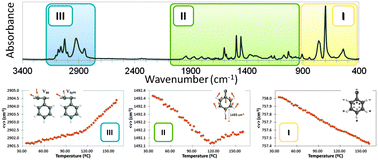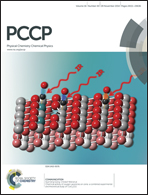New molecular-scale information on polystyrene dynamics in PS and PS–BaTiO3 composites from FTIR spectroscopy†
Abstract
A new idea to understand the macromolecular motion occurring along the thermal relaxations of polystyrene (PS) and PS–barium titanate composites is proposed. Detailed analysis of PS infrared bands provides a better knowledge of the factors affecting polymer dynamics. Average spectral positions and integrated absorbance of bands in the region of C–H out-of-plane vibrations showed a continuous decrease with temperature, whereas those in the region of aliphatic and aromatic C–H stretching vibrations showed the sharpest changes with temperature. Relaxation temperatures were determined from the changes observed in the band wavenumber or area with temperature. These results were attributed to changes in the distribution of the phenyl π-electron cloud, causing important dipole moment variations in the different vibration modes when the thermal transitions are taking place. Finally, although the presence of BaTiO3 particles does not seem to exert any specific effect on the PS dynamics in the glassy state, the Curie transition of these particles might induce a kind of confinement effect observable by FTIR.


 Please wait while we load your content...
Please wait while we load your content...